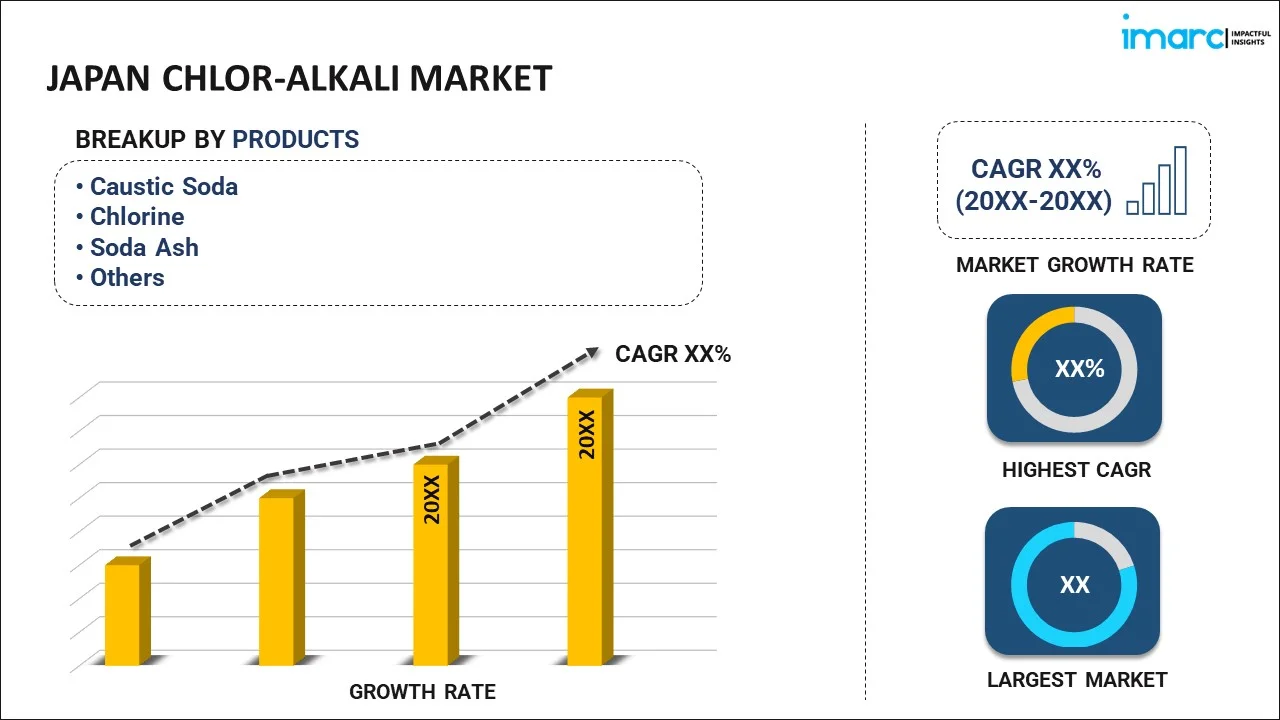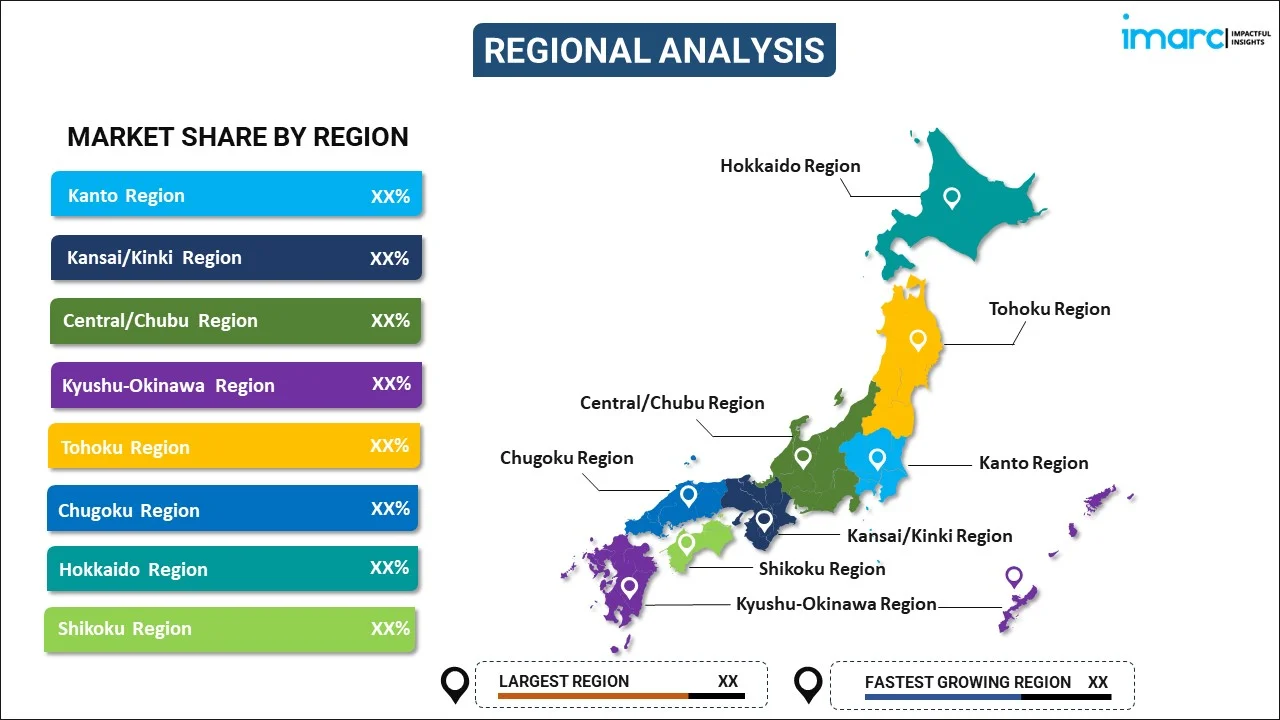
Japan Chlor-Alkali Market Report by Product (Caustic Soda, Chlorine, Soda Ash, and Others), Production Process (Membrane Cell, Diaphragm Cell, and Others), Application (Pulp and Paper, Organic Chemical, Inorganic Chemical, Soap and Detergent, Alumina, Textile, and Others), and Region 2025-2033
Market Overview:
Japan chlor-alkali market size reached USD 1.7 Billion in 2024. Looking forward, IMARC Group expects the market to reach USD 2.5 Billion by 2033, exhibiting a growth rate (CAGR) of 3.8% during 2025-2033. The growing adoption of membrane cell technology for producing high purity caustic solutions is primarily driving the market growth.
|
Report Attribute
|
Key Statistics
|
|---|---|
|
Base Year
|
2024 |
|
Forecast Years
|
2025-2033
|
|
Historical Years
|
2019-2024
|
| Market Size in 2024 | USD 1.7 Billion |
| Market Forecast in 2033 | USD 2.5 Billion |
| Market Growth Rate (2025-2033) | 3.8% |
Chlor-alkali is a chemical compound consisting of chlorine and caustic soda, created through the electrolysis of a sodium chloride solution. It is commonly employed in the production of chlorine and sodium-based products, including chlorosulphonic acid, bleaching powder, hydrogen gas, chlorinated paraffin, and polyaluminum chloride. The production of chlor-alkali typically utilizes methods such as the diaphragm cell, membrane cell, and mercury cell processes. It has wide-ranging applications, including use in water purification processes, the manufacture of plastics and resins, and the production of pure silicon, which is subsequently utilized in electronic components and solar panels. Consequently, chlor-alkali is extensively utilized in various industries such as chemicals, paper and pulp, pharmaceuticals, textiles, and the beauty and personal care sector.
Japan Chlor-Alkali Market Trends:
In the Japan market, there is currently a growing demand for caustic soda and its derivatives, driven by several key factors. This increased demand can be attributed to its substantial utility in the paper and pulp industry, textiles, and the production of various organic and inorganic chemicals. Additionally, the thriving automotive and construction industries worldwide are making significant contributions to the market's expansion in Japan. Furthermore, the ongoing process of industrial modernization and rapid industrialization is motivating leading market players to invest in research and development (R&D) initiatives and diversify their product offerings. Moreover, heightened environmental concerns have led these industry leaders to adopt membrane cell technology, which is enhancing the overall market outlook. Furthermore, there is a noteworthy uptick in the use of chlorine in healthcare facilities in Japan. This includes hyperchlorination of potable water to prevent Legionella colonization, chlorination of water distribution systems used in hemodialysis centers, disinfection of laundry, surface cleaning, local use for decontaminating blood spills, and the decontamination of medical waste before dental procedures and disposal. Other significant factors contributing to market growth include the increased demand for water treatment due to the outbreak of the coronavirus disease (COVID-19) and the expanding production capacity and exports of textiles and apparel. These factors are expected to further drive market growth in the coming years.
Japan Chlor-Alkali Market Segmentation:
IMARC Group provides an analysis of the key trends in each segment of the market, along with forecasts at the country level for 2025-2033. Our report has categorized the market based on product, production process, and application.
Product Insights:

- Caustic Soda
- Chlorine
- Soda Ash
- Others
The report has provided a detailed breakup and analysis of the market based on the product. This includes caustic soda, chlorine, soda ash, and others.
Production Process Insights:
- Membrane Cell
- Diaphragm Cell
- Others
A detailed breakup and analysis of the market based on the production process have also been provided in the report. This includes membrane cell, diaphragm cell, and others.
Application Insights:
- Pulp and Paper
- Organic Chemical
- Inorganic Chemical
- Soap and Detergent
- Alumina
- Textile
- Others
The report has provided a detailed breakup and analysis of the market based on the application. This includes pulp and paper, organic chemical, inorganic chemical, soap and detergent, alumina, textile, and others.
Regional Insights:

- Kanto Region
- Kansai/Kinki Region
- Central/ Chubu Region
- Kyushu-Okinawa Region
- Tohoku Region
- Chugoku Region
- Hokkaido Region
- Shikoku Region
The report has also provided a comprehensive analysis of all the major regional markets, which include Kanto Region, Kansai/Kinki Region, Central/ Chubu Region, Kyushu-Okinawa Region, Tohoku Region, Chugoku Region, Hokkaido Region, and Shikoku Region.
Competitive Landscape:
The market research report has also provided a comprehensive analysis of the competitive landscape. Competitive analysis such as market structure, key player positioning, top winning strategies, competitive dashboard, and company evaluation quadrant has been covered in the report. Also, detailed profiles of all major companies have been provided.
Japan Chlor-Alkali Market Report Coverage:
| Report Features | Details |
|---|---|
| Base Year of the Analysis | 2024 |
| Historical Period | 2019-2024 |
| Forecast Period | 2025-2033 |
| Units | Billion USD |
| Scope of the Report | Exploration of Historical and Forecast Trends, Industry Catalysts and Challenges, Segment-Wise Historical and Predictive Market Assessment:
|
| Products Covered | Caustic Soda, Chlorine, Soda Ash, Others |
| Production Processes Covered | Membrane Cell, Diaphragm Cell, Others |
| Applications Covered | Pulp and Paper, Organic Chemical, Inorganic Chemical, Soap and Detergent, Alumina, Textile, Others |
| Regions Covered | Kanto Region, Kansai/Kinki Region, Central/ Chubu Region, Kyushu-Okinawa Region, Tohoku Region, Chugoku Region, Hokkaido Region, Shikoku Region |
| Customization Scope | 10% Free Customization |
| Post-Sale Analyst Support | 10-12 Weeks |
| Delivery Format | PDF and Excel through Email (We can also provide the editable version of the report in PPT/Word format on special request) |
Key Questions Answered in This Report:
- How has the Japan chlor-alkali market performed so far and how will it perform in the coming years?
- What has been the impact of COVID-19 on the Japan chlor-alkali market?
- What is the breakup of the Japan chlor-alkali market on the basis of product?
- What is the breakup of the Japan chlor-alkali market on the basis of production process?
- What is the breakup of the Japan chlor-alkali market on the basis of application?
- What are the various stages in the value chain of the Japan chlor-alkali market?
- What are the key driving factors and challenges in the Japan chlor-alkali?
- What is the structure of the Japan chlor-alkali market and who are the key players?
- What is the degree of competition in the Japan chlor-alkali market?
Key Benefits for Stakeholders:
- IMARC’s industry report offers a comprehensive quantitative analysis of various market segments, historical and current market trends, market forecasts, and dynamics of the Japan chlor-alkali market from 2019-2033.
- The research report provides the latest information on the market drivers, challenges, and opportunities in the Japan chlor-alkali market.
- Porter's five forces analysis assist stakeholders in assessing the impact of new entrants, competitive rivalry, supplier power, buyer power, and the threat of substitution. It helps stakeholders to analyze the level of competition within the Japan chlor-alkali industry and its attractiveness.
- Competitive landscape allows stakeholders to understand their competitive environment and provides an insight into the current positions of key players in the market.
Need more help?
- Speak to our experienced analysts for insights on the current market scenarios.
- Include additional segments and countries to customize the report as per your requirement.
- Gain an unparalleled competitive advantage in your domain by understanding how to utilize the report and positively impacting your operations and revenue.
- For further assistance, please connect with our analysts.
 Inquire Before Buying
Inquire Before Buying
 Speak to an Analyst
Speak to an Analyst
 Request Brochure
Request Brochure
 Request Customization
Request Customization




.webp)




.webp)












